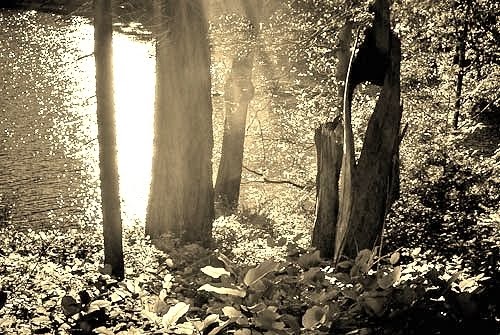Homework. There is none
as such, but please continue to work with 'the thing' with any new
understanding that you received during the course of the workshop
session. You may wish to re-read Szarkowski and look ahead into his
discussion of 'detail'.
The workshop went well from the
teacher's perspective. We received some nicely representative images
for workshopping that allowed us to discuss the many ways of thinking
about 'the thing itself'. One aspect that came up often was that the
'thing' was often not simply the subject matter - the leg hold trap
could be about pain, and the two sheep might be about the
golden light of evening. We worked through the formal analysis
and as a group critiqued very well. Our aim was to encourage student
participation and to develop skills of analysis. We all found how
individual our views about a photograph can be and yet we all could
open our eyes a little wider when we finished. Baudelaire wrote about
the role of art criticism as a “widening of the horizon” and that
is what we experienced today.
Here is a little piece about
detail which
will be the topic for May: I thought it was nicely shocking to
compare Art photography with something so commercial as advertising.
Ansel Adams though, might have seen my point.
The Detail, Advertising and
Communication
Szarkowski when he writes about
Detail emphasizes how important selection of the appropriate detail
is when planning a photograph: we “isolate the fragment, document
it and and ....claim for it some special significance, a meaning
which [goes] beyond simple description”. The image can be read as a
symbol, as “filled with undiscovered meaning”.
I listened to a radio program about
advertising this morning, and was struck by the parallel with
selecting the detail when making/taking a photograph. The subject
being discussed was the 'elevator pitch'; that one sentence,
succinct, clear enunciation of an idea within the time it takes an
elevator to pass from one floor to another. The main example was when
Steve Jobs was trying to lure a Pepsi executive to come and work for
Apple. All efforts failed, even an enormous offer of money did not
sway Mr. Scully, but what finally moved him was this: “ Do you want
to sell sugar water all your life or change the world?”
My point is that choosing the detail
that your image will present to the world is very important. One
powerful image, clearly expressed is worth more than many another
rambling and unfocussed one. It will catch the viewers attention,
just as a strong graphic or slogan does in advertising, and without
that we cannot communicate at all, but then, with the viewer's
attention held for a few seconds, if our image actually stands for
something worthwhile we can bridge the communication gap between
maker and viewer.
The radio program asks what business we
are in and gives the example of Nike shoes: 'Shoes' is the product
but what is the company's core purpose: 'Shoes' or 'Just do it!'? It
is selling life style, the shoes are secondary. This also can relate
to photography and selection of the appropriate subject
matter or detail. If a photograph's main function is not to 'make the
story clear' but to 'make it real' as Szarkowski writes, then we need
to 'tap a universal desire or symbol' just as good advertising does,
and that requires some pre-thought or at least a recognition of a
great detail when we see it.
Good advertising
and good photography have this in common, both are in the business of
communication, so clarity and succinctness and the right image for
the right purpose is important. Choose your detail with care.
Extra 1
Progress in photography?
A topic that surfaced during the
discussion last Sunday was that of 'progress' through time. The idea
that recent photography is superior, is more evolved than
older styles. This idea is common enough in all areas of thought and
seems self evident: are we not smarter and more advanced than our
parents, is not Western civilization the pinnacle of human
development? You can see that I am being provocative here; few of us
today, on the brink of war or of dramatic climate change, would think
so anymore, and the older we get the smarter our parents seem in
retrospect.
One of
the tenents of art criticism is that we cannot, or should not, class
works of art by the old Victorian standards of 'progress' and that a
work of art, whether it be a superb photograph from the last
century, or a painting from several centuries ago or a sculpture from
many thousands of years ago, be it the Greek Venus de Milo or that
little earth goddess, the Venus of Willendorf, has its own special
beauty that exists separately from time, is eternal. It is our job to
dig a little deeper until we begin to grasp what is being presented
to us. We do not judge or classify, but seek to understand, a much
more humble and productive place to be.
So
modernism as promoted by Szarkowski preceded post-modernism, but
that is all that can be said. In fact many photographers may slide
all over the map and not feel that the latest Art photography ideas
are the only way to express themselves. There is a long history of
art from the distant past to the near present and like the authors
who line the shelves of a library, they all have something to
communicate to us that pushes aside time and can be relevant to our
present concerns.
